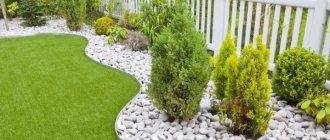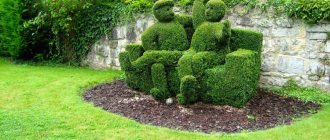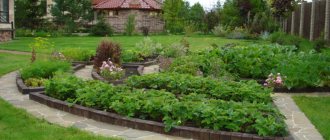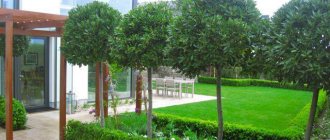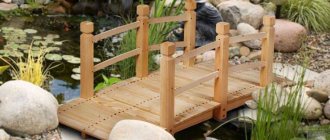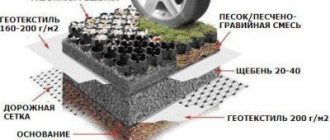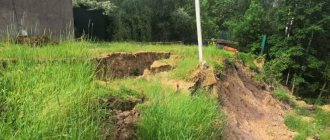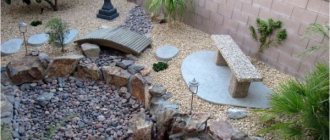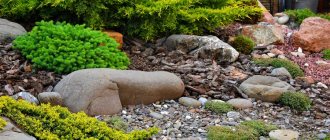Review author: Terrari School of Design
Decorative figures are often used in landscape design. These small architectural forms can reflect the direction of design art and become a decoration of the garden area. Thanks to these details, it is possible to create a comfortable atmosphere and add bright notes. They are able to make the landscape of the territory unique.
How to make figurines for the garden? We present several options for DIY crafts. The only requirement when choosing available means and production methods is that the decorative element matches the appearance of the garden and the residential building.
A little history
The use of small architectural forms began in the Renaissance, when landscape gardening ensembles became widespread in Europe. Specialists of various levels worked on their creation: from a simple gardener to a famous architect or sculptor.
In the countries of the East, since ancient times, small architectural forms have been an integral part of gardens of contemplation.
Decorative fountains, pagodas, compositions made of stones - all these design elements not only had a symbolic meaning, but also contributed to creating a mood of calm and tranquility.
In Rus' they have always loved working with wood. Carved pillars with fancy figures of animals and birds. Figures of epic heroes. Benches. Wells. All this will later be adopted by landscape designers in their work.
Wooden sculptures for the garden and their photos
Wooden sculptures for the garden are carved from a single tree trunk, woven from branches, and assembled from knots. Products with different character and mood are appropriate in different areas of the garden. At the entrance to the forest part of the garden, you can place gnarled sculptures for the garden, reminiscent of a forest animal or a fairy-tale character. A children's playground is a suitable place for animal figures and fairy tale heroes. A decorative garden can be decorated, for example, with a large pumpkin or figurines of domestic animals.
Look at the wooden sculptures in the photo, which show many examples of their use:
Furniture as sculpture. Creatively thinking people sometimes make garden sculptures from the simplest and most ordinary things. For example, they take the frame of a chair, arrange a flower bed with flowers instead of a seat and install it in a suitable place in the garden - it turns out quite nice. A similar idea is embodied in a rather rusty set of a table, decorated with a composition of containers with juveniles, and two chairs. If the rest of the garden is beautiful and well-groomed, then such a neglected “sculpture” will only decorate it.
Designer pieces made from a single piece of wood are always impressive, for example, a sculpture representing a palm bent in a certain way so that it looks like a garden chair.
Wells as sculpture. A well can look like an original sculpture in the garden. There are two possible options here.
In the first option, they take a well and make it like a house with a roof of varying degrees of intricacy, the main thing is that in terms of the style and materials of the side walls and roof it matches the house on the site.
The second option is when it is not tied to a real well of water, but simply depicts it. It is good to support such a sculpture with a rocker, some other well accessories, or other wooden sculptures. If it was done by a real artist, it looks great.
Purpose
Small architectural forms should not only add variety to the decor of the garden, but also perform practical functions.
You can sit on a comfortable bench, a gazebo entwined with greenery will save you from the scorching sun on a hot day, and a pergola will become a support for climbing plants.
What can be made from plastic bottles?
The advantage of this available material is its ability to retain its shape for a long time. In addition, bright plastic does not fade under the influence of solar insolation. It is possible to create a complex composition from ordinary bottles. For example, a palm tree from the hot tropics. Flowers and birds of paradise are made from polymer plastic.
Caring for such crafts is easy and simple. To do this, it is enough to remove traces of dirt with plain water.
Material
Decorative elements in a garden plot must be of high quality, but they do not necessarily have to be expensive.
To create them, you can contact a specialist, or you can do it yourself. In this case, a creative approach is encouraged, which is manifested in the originality of the design and the selection of unusual materials.
For small architectural forms you can use the classics: metal, wood, brick, stone (natural and artificial). Or you can find a use for old unnecessary things or even garbage.
You can look for ideas for decorating a garden plot in magazines for gardeners, where a huge number of photos of small architectural forms are presented. Or look through the pages of the Internet.
Rotunda
It is very similar to a gazebo, but differs in its obligatory round shape and the presence of a dome and colonnade. Typically, a rotunda is built of stone or brick.
This type of building is much less common in landscape design, since it does not always fit organically into the garden plot.
- A DIY mailbox is a beautiful decoration and a useful addition to a suburban area
A house for children is a place where a fairy tale becomes reality, we create it ourselves
Bridges for a dacha - a picturesque element of the landscape in a suburban area
Natural wood products
The wooden base is considered a unique type of material that allows you to create various options for garden decor. If you have basic skills in carving and burning techniques, you can quickly transform an old stump. The finished product can decorate any corner of the garden.
To prevent the wooden craft from being spoiled by insects and fungi, it is recommended to coat the surface of the product with furniture varnish. The protective coating is applied in several layers and left until completely dry.
Trellis
Structure for supporting climbing plants. This is a light lattice, which, together with overgrown bindweed, creates a vertical screen and divides the garden space into separate zones.
Wooden slats, metal rods or even thick wire are used as materials for trellises.
Garden bridges
These small structures are installed in areas both above the water and above the path or above the so-called dry stream. Their placement should be logical and functionally justified.
Such a bridge can be a crossing point over a stream or simply an observation deck from which beautiful views open up.
They can be built from wood, stone or metal.
Rules for placement on the territory
Regardless of what kind of decorative element you plan to place, you always need to take into account several basic nuances that will allow you to maintain the harmonious appearance of the entire site. Namely:
All decorative elements that will be erected on the site must fit harmoniously and in no case disturb the overall perception of the garden as a whole. Therefore, this process is best left to professionals, especially if it is planned to build voluminous and large-sized objects on the site. For example, gazebos, ponds or attics.
garden furniture
First of all, these are benches. Despite their simplicity and small size, it is the benches that bring home comfort to the garden space. They can be dispersed throughout the territory: along paths, near a fountain, in a gazebo.
Externally, they can be either very simple or with an original design. With and without backs. Portable or buried in the ground. Wooden, metal and stone.
The main thing is that they should be comfortable. Well, beautiful.
Fountains
A fountain can become the pride of a site. It can be placed in the middle of the pond, or it can be made into a separate structure. In the latter case, the drainage system needs to be thought through at the design stage.
Decorative small architectural forms
These are garden decorations, sculptures, figures and flowerpots. The design of these architectural forms can be very diverse.
Sculptures are usually placed on elevations, and they are designed for all-round visibility. Of the garden figures, gnomes and images of animals are most often used.
Flowerpots can be of any size and shape. Some also include elements of sculpture, which makes them real works of art.
Sports grounds
If the space of the site allows, then you can build a sports ground. Both adults and children will enjoy spending their free time there.
A sports ground can be built outdoors, under a canopy, or even in a pavilion.
At a summer cottage, the set of sports equipment is minimal: a horizontal bar, parallel bars, a monkey bars, a bench for lying down. You can do all this yourself.
When arranging a sports ground, you need to consider some points:
The site should be in a shaded area to avoid practicing in direct sunlight and to avoid overheating of the equipment. Otherwise, it is better to build a protective awning.
There should be no flower beds, trees or beds near the site. This will help prevent injuries during training and not damage the plants.
The sports ground should not be located in a low place to prevent water from accumulating on it. Or make good drainage.
To cover the site, you can use either natural or rolled turf, rubber covering (regupol) or self-leveling covering (concrete screed)
Master class on creating a duck from plaster
To create unusual figures from liquid plaster, you will need a special silicone mold. This blank will allow you to give realistic shapes to your future garden decor. You can purchase these products in specialized departments for creativity or in garden centers.
We offer an interesting master class on making a duck from plaster. For this we need:
- Dry plaster 5 kg;
- 10 liters of water;
- Silicone mold accurately repeats the silhouette of the bird;
- Oil or acrylic paints for drawing lines;
- Container for mixing ingredients;
- Metal wire for connecting mold parts.
The first step is to prepare a gypsum base. To do this, combine dry plaster and 10 liters of liquid in a deep container. The entire mixture is thoroughly mixed until the dry parts are completely dissolved.
Now you need to prepare the form. To do this, its surface is thoroughly wiped with an alcohol solution. This will prevent bubbles from appearing on the surface of the decor after it dries. After this, carefully pour the liquid mixture into the silicone blank.
Using metal wire, we tightly fix the two parts to each other. We leave the plaster duck to dry for 3-4 hours. After this time, carefully disconnect the two halves and check the integrity of the structure. The presence of external effects can be corrected with a damp brush.
When the plaster decor is completely dry, you can proceed to painting it. To do this, use oil or acrylic paint to paint individual parts of the bird. For example, the wings and neck can be painted in a light gray shade, and the body in beige. The photo of the garden figurine shows the finished product.
Children's playgrounds
If there are children in the house, then a great solution would be to make a play area for them in the yard. Architectural forms for children's playgrounds include swings, sandbox, house, stairs, slides, etc.
The gaming complex can be either ordered ready-made (plastic buildings are especially popular) or made with your own hands.
In this case, you can show your imagination and make children's architectural forms original and interesting. For example, what child doesn’t dream of a tree house? Or about a little house with painted shutters.
Diversify the design of your summer cottage with small architectural forms. This will not only make your site functional and harmonious, but will also add zest to the appearance of your garden.
MAF classification
Small architectural forms differ in their purpose and are divided into three types:
- universal (for general daily use) - flowerpots, lanterns, benches, trash cans, etc.;
- decorative (to decorate the environment) - statues and sculptures of various shapes, fountains, gazebos, mosaic pool bases, bridges and artificial streams;
- leisure (for children's and sports games) - sandboxes, swings, slides, wall bars.
There is another way to divide the MAF according to its intended purpose; according to this method, two groups are obtained:
- small architectural forms designed to evoke visual and aesthetic pleasure, please the eye and create a cozy atmosphere;
- applied architectural forms responsible for comfortable living and recreational conditions.
Among the small architectural forms of the second group, several subspecies are distinguished:
- MAFs that delimit space visually divide the area into several parts: they separate the rest area from the working area, and hide equipment and tools behind a partition or canopy. These include: fences, stairs, bridges, retaining walls, arches, fountains and flowerpots.
- LFAs that equip recreation areas: gazebos, garden furniture, benches, swings, barbecues and barbecues, children's and sports grounds.
- LFAs responsible for the convenience of the area for people: lanterns and lamps, trash cans, drinking fountains.
Small architectural forms are also distinguished by the use of vegetation:
- MAF using plants (vases, pergolas, bosquets);
- MAF without plants.
Read the article on how to build a playground yourself.
Learn how to stabilize the soil and decorate your site with a homemade retaining wall.
Another large group of MAFs is distinguished based on the material used to make a particular shape:
- concrete;
- metal alloys;
- ornamental stone;
- natural materials (wood, wicker).
Sometimes several materials are used (for example, a forged cast-iron gazebo trimmed with natural stone).

